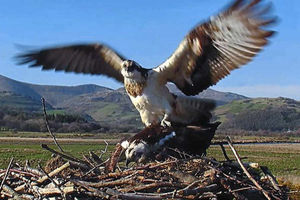Osprey Monty at top of the tree as war wages over control of nest
Nest wars are being fought high in the trees in mid-Wales.

A day after the first osprey was spotted returning to a nesting area after the winter break in Africa, the nest's owner swooped in to chase off the usurper and take his place at the top of the tree.
In what was almost a repeat of events last year, Monty the osprey returned to his nest near Machynlleth, which is looked after by the Dyfi Osprey Project, to find younger male Dai Dot already there.
And when Monty's mate for the past two years, Glesni, arrived, she found another female, Blue 24, getting friendly with Monty.
Dai Dot had been the first osprey to make a return, landing on Easter Monday. He was followed on Tuesday morning by Blue 24, who had a brief liaison with Dai Dot in 2014 on the Dyfi nest before resident breeding pair Monty and Glesni arrived.
In the afternoon a third bird joined the fray when Monty landed on the nest, to the delight of staff at the Dyfi Osprey Project.
Emyr Evans, of the Dyfi Osprey Project, said: "It's been one of those magical days on the Dyfi that crop up from time to time. Not only did one osprey turn up, three did.
"At about 2.20pm after the warm-up acts, the main man made his entrance. Monty left his Dyfi nest last year on September 7, and exactly seven months to the day later on April 7, he returned. He looks in great shape."
The team was even more delighted when Glesni made an appearance yesterday morning. When she returned last year she found Monty plying Blue 24, her cousin, with gifts of freshly-caught fish.
After three attempts to oust Blue 24, Glesni finally retook her nest and went on to produce two chicks with Monty.
This year it was a little easier, with Blue 24 conceding the nest at Glesni's first approach, and Monty and Glesni mating for the first time at 9am.
The birds spend the winter in Africa before flying 3,000 miles back to the area to breed. They have been recorded at the Dyfi nest for the past seven years.
Bird watchers can keep up with the latest comings and goings through the 24-hour video streaming feed at www.dyfiospreyproject.com/stream




